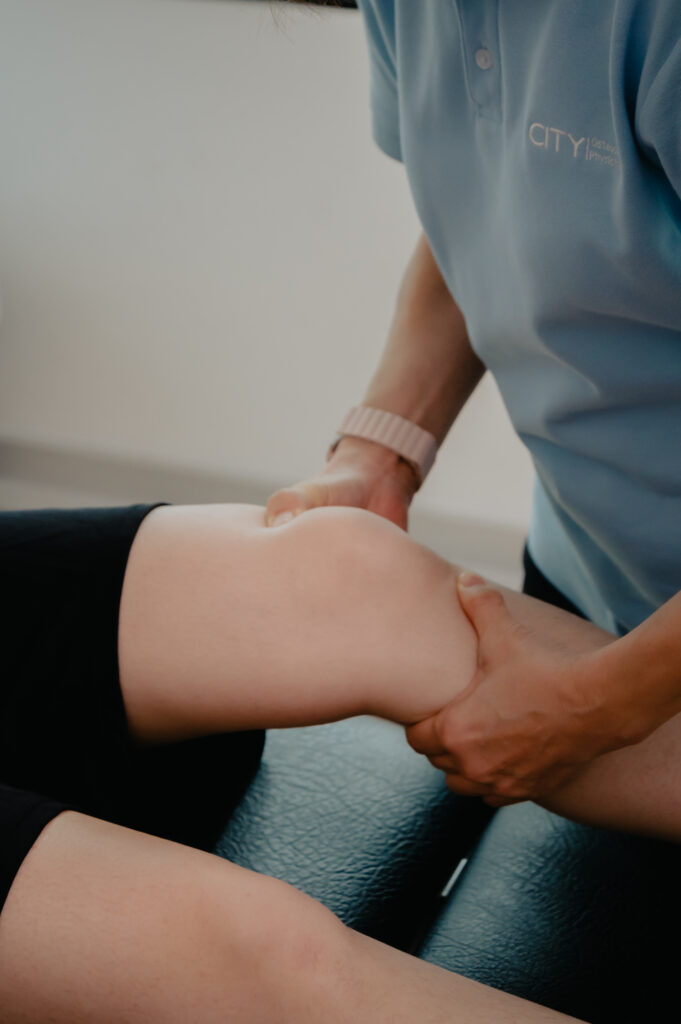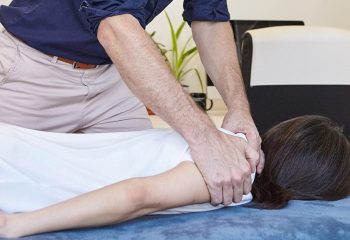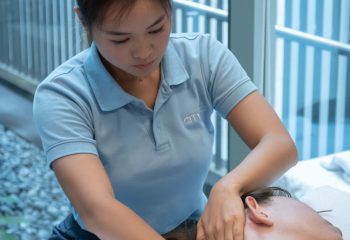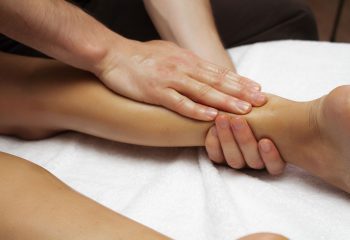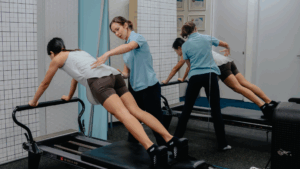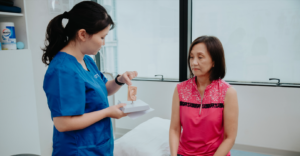In the world of active lifestyles and sports, ACL injuries can be a formidable setback. However, the journey towards recovery doesn’t end with surgery. This is where ACL reconstruction physiotherapy steps in, offering a tailored roadmap to regain strength, flexibility, and confidence. Let’s embark on a deep dive into the realm of ACL reconstruction physiotherapy, exploring its pivotal role in reclaiming an active and vibrant life post-injury.
What is Anterior Cruciate Ligament (ACL) reconstruction?

The anterior cruciate ligament, or ACL, is one of the major ligaments in the knee. It plays a pivotal role in maintaining knee stability during various activities, including jumping, cutting, and pivoting. Unfortunately, injuries to the ACL are common, particularly among athletes engaging in high-intensity sports.
ACL reconstruction is a surgical procedure aimed at repairing a torn or injured ACL. It involves replacing the damaged ligament with a graft – usually a piece of tendon from the patient’s own body or a donor. While the surgery itself is a crucial step towards recovery, what comes next is equally significant.
Why is physiotherapy crucial after ACL reconstruction?
Enter the unsung hero of ACL recovery – physiotherapy. Physiotherapy plays a pivotal role in aiding ACL reconstruction recovery by providing a structured and personalised approach to rehabilitation. Our skilled physiotherapists here at City Osteopathy and Physiotherapy work closely with patients to create a tailored treatment plan that addresses their specific needs and goals. This involves a combination of exercises, manual therapy, and education on proper movement mechanics. This ensures one’s long-term wellbeing and a confident return to an active lifestyle.
What are the key benefits of ACL reconstruction physiotherapy?
Embarking on the journey of ACL reconstruction physiotherapy brings forth a wealth of advantages that extend far beyond the realm of recovery. Let’s take a closer look at the key benefits that make this process an integral part of your path to renewed vitality and wellbeing.
1. Accelerated recovery
Physiotherapy acts as a catalyst for your body’s natural healing processes. Through targeted exercises and interventions, it enhances blood circulation, reduces inflammation, and promotes tissue regeneration. This means you can regain your stride quicker than you might on your own.
2. Minimised risk of complications
ACL reconstruction surgery, while effective, carries its fair share of risks, including post-operative complications. Physiotherapy under expert guidance ensures that potential issues like scar tissue formation, stiffness, and joint instability are addressed proactively, reducing the likelihood of complications.
3. Restored range of motion
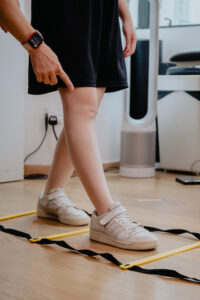
After surgery, the knee joint might experience stiffness and limited range of motion. Physiotherapists use a combination of stretching exercises, manual techniques, and joint mobilisations to gradually restore your knee’s flexibility, ensuring you can move comfortably and freely.
4. Improved muscle strength and balance
ACL injuries can lead to decrease in muscle and muscle imbalances. Physiotherapy focuses on strengthening the muscles surrounding the knee, not just for support but to restore a harmonious balance between muscle groups. This is crucial for preventing undue stress on the joint and reducing the risk of future injuries.
5. Smooth transition to activities
Whether you’re an athlete or simply an active individual, physiotherapy paves the way for a smooth transition back to your favourite activities. From walking and climbing stairs to more dynamic movements like running and jumping, your physiotherapist guides you towards performing these actions confidently and safely.
6. Reduced risk of re-injury
One of the primary goals of ACL reconstruction physiotherapy is to fortify your knee against future injuries. By addressing muscle imbalances, enhancing stability, and refining movement mechanics, you’re less likely to find yourself back on the recovery path due to a re-injury.
In essence, ACL reconstruction physiotherapy is more than just a regimen of exercises – it’s a comprehensive approach to rehabilitation that empowers you to regain control over your body and your life. With a focus on holistic healing, guidance from a professional physiotherapist, and a personalised plan, you’re on the fast track to redefining your limits and embracing a future filled with vitality.
How do physiotherapists address ACL injuries?
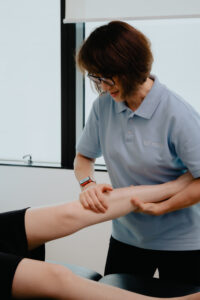
Physiotherapists employ a comprehensive and multi-stage approach to address ACL injuries and guide patients through their recovery journey. Here’s how they typically address ACL injuries:
- Assessment and evaluation: Physiotherapists begin by assessing the severity of the ACL injury, understanding the patient’s medical history, and evaluating any accompanying issues. This helps them tailor a treatment plan to the patient’s specific needs.
- Pain and swelling management: Initially, the focus might be on reducing pain and swelling through techniques like ice, compression, and elevation. This prepares the body for subsequent rehabilitation exercises.
- Range of motion: Physiotherapists work to restore the knee’s range of motion, as post-surgery stiffness is common. They use gentle stretching exercises, manual techniques, and joint mobilisations to gradually increase flexibility.
- Muscle activation: Muscle decrease and weakness are common after ACL injuries. Physiotherapists design exercises to activate and strengthen the muscles around the knee joint, helping to provide stability and support.
- Proprioception and balance: Physiotherapists introduce exercises that challenge patients’ balance and proprioception (awareness of body position). These exercises help retrain the body’s neuromuscular control and restore stability.
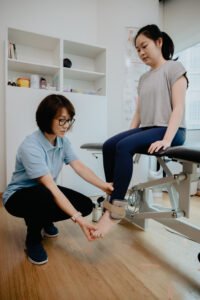 Progressive strengthening: As the patient’s condition improves, physiotherapists design progressive strengthening exercises. These target not only the muscles around the knee but also those that support the entire lower body.
Progressive strengthening: As the patient’s condition improves, physiotherapists design progressive strengthening exercises. These target not only the muscles around the knee but also those that support the entire lower body.- Functional activities: Physiotherapists gradually introduce functional activities that mimic real-life movements. This could involve controlled squatting, lunging, and stepping, preparing the patient for a return to daily activities and sports.
- Plyometric and sport-specific training: In the later stages of recovery, physiotherapists incorporate higher-impact exercises like jumping and hopping. These activities mimic the demands of sports and help patients regain confidence in dynamic movements.
- Education: Throughout the process, physiotherapists educate patients about proper movement mechanics, body mechanics, and strategies to prevent future injuries. This knowledge empowers patients to maintain their progress and stay safe.
- Monitoring and adjustments: Physiotherapists closely monitor the patient’s progress and adjust the treatment plan as needed. They may modify exercises, increase intensity, or introduce new challenges based on how the patient responds.
- Psychological support: Recovery from an ACL injury can be mentally challenging. Physiotherapists provide emotional support, motivation, and guidance to help patients navigate the ups and downs of the recovery process.
- Return to sport clearance: Physiotherapists work in coordination with the medical team to determine when a patient is ready to return to sports. This decision is based on the patient’s physical readiness and the specific demands of their chosen activity.
By addressing various aspects of recovery, physiotherapists help patients rebuild strength, stability, and confidence after an ACL injury, ultimately guiding them back to an active and fulfilling lifestyle.
How long does the typical ACL reconstruction physiotherapy process last?
While individual timelines may vary, a typical ACL reconstruction physiotherapy process spans several months. The initial phase focuses on reducing swelling, regaining range of motion, and strengthening the muscles surrounding the knee joint. As you progress, the intensity and complexity of exercises increase, bringing you closer to your pre-injury state.
What are the do’s and don’ts during the initial phases of ACL construction recovery?
Do:
- Follow medical advice: Adhere to your doctor’s and physiotherapist’s instructions carefully.
- Practice gentle movements: Engage in gentle exercises recommended by your physiotherapist to aid circulation and prevent stiffness.
- Control swelling: Use ice and elevation to manage swelling and discomfort.
- Maintain consistency: Stick to your prescribed exercises and appointments to ensure steady progress.
Don’t:
- Rush into high-impact activities: Avoid engaging in high-impact or strenuous activities too soon, as your body needs time to heal.
- Neglect rest: Give your body sufficient rest to facilitate healing and prevent overexertion.
- Disregard pain signals: If an exercise causes severe pain or discomfort, stop and consult your physiotherapist.
- Skip follow-up appointments: Regular appointments with your physiotherapist are crucial for tracking progress and making necessary adjustments.
What physiotherapy exercises promote strength and flexibility post-ACL reconstruction?
To regain strength and flexibility after ACL reconstruction, your physiotherapist may recommend various exercises tailored to your needs:
- Straight Leg Raises: Lie on your back and lift your injured leg while keeping it straight. This strengthens your thigh muscles.
- Heel Slides: Gently slide your heel towards your buttocks while lying down, bending your knee. This improves knee flexibility.
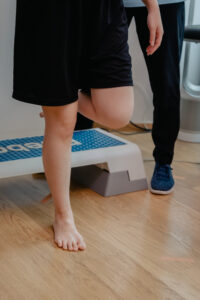
- Hamstring Curls: While standing, bend your knee to lift your heel towards your buttocks. This strengthens the hamstrings.
- Quadriceps Sets: Sit with your leg straight, tighten your thigh muscles, and press the back of your knee into the floor. This strengthens the quadriceps.
- Calf Raises: Stand on both feet and lift your heels, then lower them down. This works the calf muscles.
- Stationary Bike: Using a stationary bike can help improve knee range of motion and overall leg strength.
Remember, these exercises should be done under your physiotherapist’s guidance and gradually progressed as your recovery advances.
Are there potential challenges in ACL reconstruction physiotherapy?
While ACL reconstruction physiotherapy offers immense benefits, there can be challenges to overcome:
- Frustration: Progress may feel slow at times, leading to frustration. Trust the process and communicate with your physiotherapist about your concerns.
- Discomfort: Some exercises might initially cause discomfort or mild pain. Your physiotherapist will guide you on differentiating between normal discomfort and potentially harmful pain.
- Consistency: Staying consistent with exercises and appointments can be challenging, but it’s essential for optimal recovery.
- Mental strain: Dealing with the mental aspect of recovery can be tough. Physiotherapists offer support and motivation to help you stay positive.
- Returning to activities: The transition back to regular activities and sports requires careful progression to avoid re-injury. Follow your physiotherapist’s guidance.
Remember, your physiotherapist is there to help you navigate these challenges and ensure a successful recovery. Open communication and dedication to your rehabilitation plan are key to overcoming these hurdles.
What is the cost of ACL reconstruction physiotherapy?
The cost of ACL reconstruction physiotherapy can vary depending on factors such as location, the extent of the injury, and the number of sessions required. Some insurance plans may cover a portion of the expenses. It’s essential to discuss the financial aspect with your healthcare provider and explore any available options. Check out our fees and insurance for more guidance.
FAQs about ACL reconstruction recovery and physiotherapy
I experience post-op pain after my ACL reconstruction surgery. What should I do?
Post-operative pain is normal. Follow your doctor’s prescribed pain management plan, and communicate any concerns with your medical team. Rest assured, the pain should gradually decrease as you progress.
Can I go jogging after ACL reconstruction?
Jogging can be introduced later in your recovery journey, under the guidance of your physiotherapist. It’s essential to allow your knee sufficient time to heal and build up strength before engaging in higher-impact activities.
How soon can I return to exercise or play sports after ACL recovery?
Returning to exercise or sports is a gradual process that varies from person to person. Your physiotherapist will determine the right time based on your progress and the specific demands of your chosen activities.
Can physiotherapy prevent re-injury after ACL reconstruction?
Absolutely. Through targeted exercises that address muscle imbalances, enhance stability, and improve movement mechanics, physiotherapy significantly reduces the risk of re-injury, setting you up for a more secure and confident return to your active lifestyle.
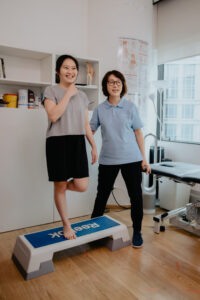
ACL reconstruction physiotherapy: Conquering your path to recovery
In the intricate dance of recovery after ACL reconstruction surgery, physiotherapy emerges as an indispensable partner. It’s more than a series of exercises; it’s a transformative journey that leads you back to strength, flexibility, and vitality. From accelerated healing and minimised complications to restored range of motion, muscle strength, and balance, physiotherapy empowers you to reclaim control over your body and life. With the guidance of skilled physiotherapist, a personalised plan, and a commitment to the process, you’re on the path to not just recovery, but a future of long-term wellbeing and active living. Consult our experienced physiotherapy team to devise a recovery strategy that’ll have you back to your pain-free self in no time.

